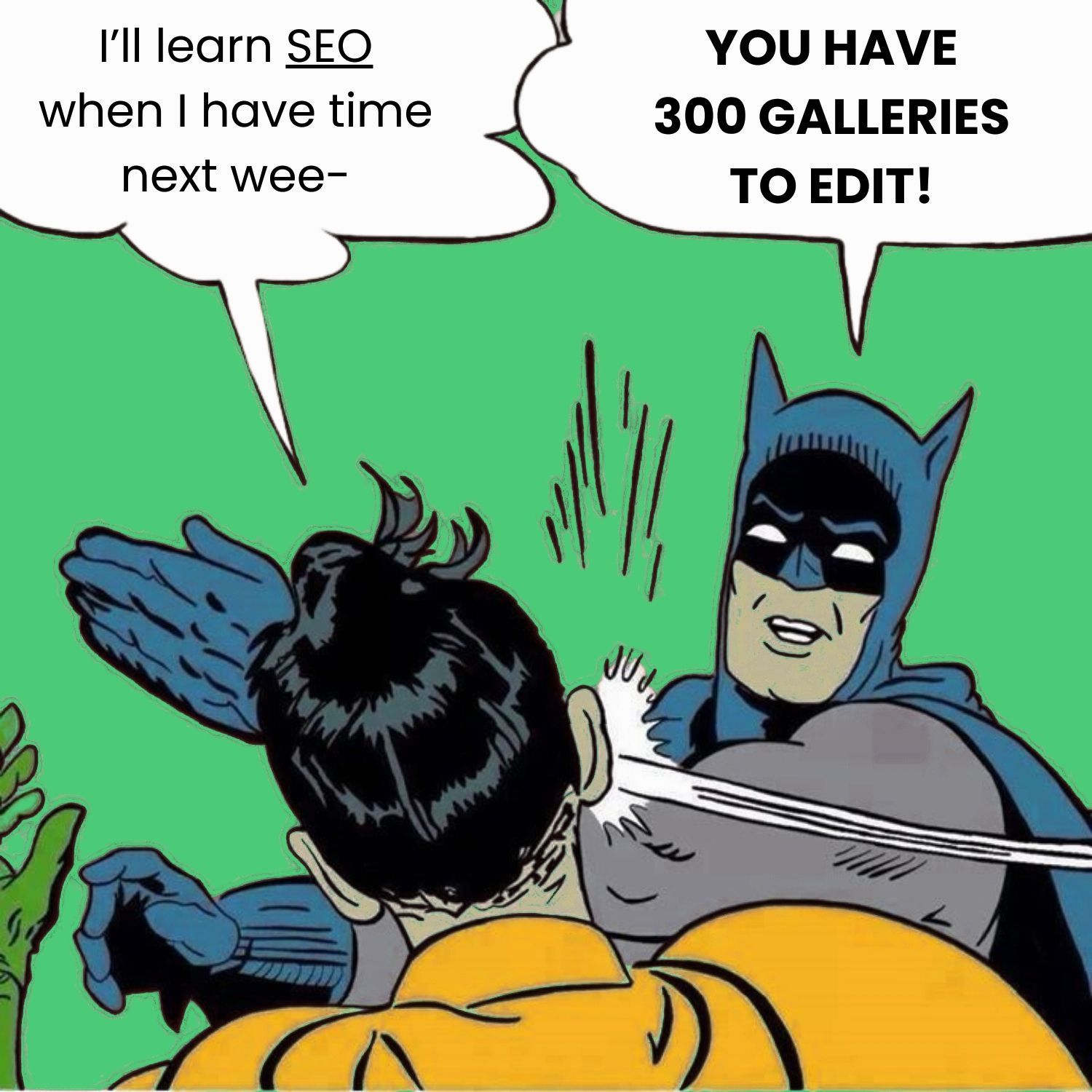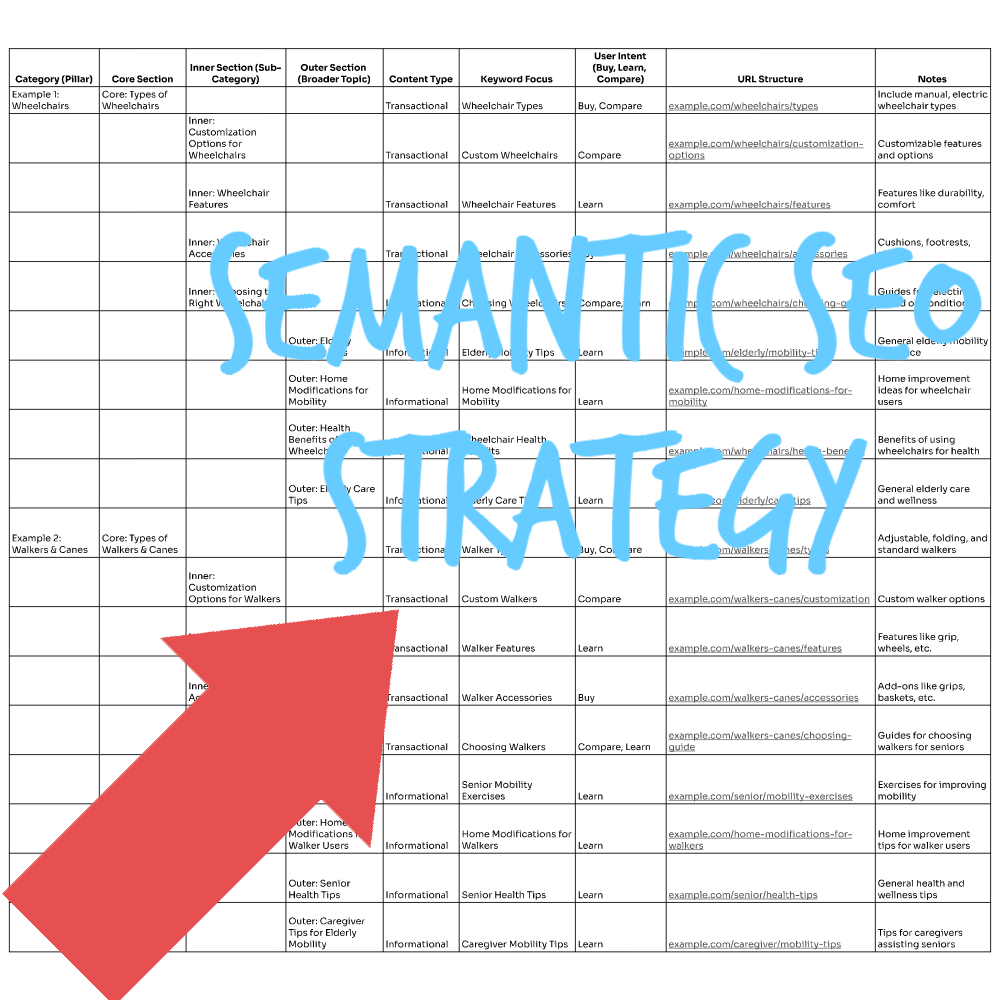SEO For Photographers: SEO DIY Checklist (19 Things)
PDF Download at the end

Here is your SEO for Photographers: DIY SEO Checklist of 19 things to help you with your photography business.
SEO is not complicated, but it can be time-consuming.
Here is a list to help you avoid losing all the time wondering where to start.
1. Define Your Services Clearly
You won’t get far if you’re not clear on the services you provide. List them all out.
- Wedding Photography
- Family Photography
- Senior Portraits
- Couples Photography
- Engagement Photography
- Etc.
2. Identify Your Top Priority Services
This will help you figure out which service pages to focus on first.
- The services that make you money
- The services you're best at
- The niche you want to be known for
3. Google Ranks Pages, Not Websites
Remember, each page can rank for it’s own keyword. A well-built page that goes deep can be better than having 10 shallow pages that don’t help anyone.
- Knowing this will help you prioritize the “higher opportunity” or less competitive pages.
- Start with easy wins and work towards the more difficult rankings.
Example: Your “Family Photography” page might rank #8, but your Wedding Photography page could rank in the 30’s. That’s ok. Keep building and working on your pages.
4. Optimize for Your Location
Target your city and surrounding small towns on each of your service pages and your home page. (e.g., Knoxville, Tennessee)
- Use location-specific phrases like "Family Photographer in Knoxville, Tennessee" as your main Header on your family photography page.
- Or “Knoxville, TN Family Photographer”, etc.
5. Build Content Around Your Location
Make sure each service page reflects your location to capture local search traffic.
- If you provide services in other small towns, it might make sense to build a page focused on that location.
6. Conduct Keyword Research
Keywords are what people type into Google to find services and absolutely foundational to any SEO strategy.
- Go deep and far with keyword research - this is upfront work, but worth it.
- Create spreadsheet and start adding your keywords.
- Create a second column for a pillar (ex. Family photography, wedding photography, etc.) to differentiate the categories.
- Focus on Keywords that are “buying terms” first. Think Transactional, or Bottom of the Sales Funnel type words - when visitors are ready to buy.
Example: "Family Photographer in Knoxville, Tennessee" implies that someone is searching for a family photographer to book a session with.
Whereas “Family Photography locations in Knoxville, Tennessee” would imply they are just gathering information.
- You can use paid tools like Ahrefs, Semrush, Search Atlas, but these can be expensive for the DIYer.
- Sometimes these will have free trials or you can use limited features for one site.
- Free tools like Google Search Console (more below) can also help)
- Research your competitors’ keywords and the competition level if you have access to tools.
Make a list of all possible keywords that you could rank for with all types of variations and search intent:
Transactional Examples:
- Family photography Knoxville
- Family photographer knoxville
- Knoxville family photography
- Knoxville family photographer
- Family photographers in knoxville
- Family photography in Knoxville
- Family photos Knoxville
- Best family photographers knoxville
- Etc.
Informational Examples:
- Family photography locations in Knoxville
- Where to take family photos in Knoxville
- Knoxville photography locations
- What to wear to a family photoshoot
- Family photoshoot posing ideas
- Etc.
Then come up with a plan of which keywords should be primary, and start to build your content and pages around it.
7. Conduct Competitor Research
A good overview of your competitors will help you know how to differentiate yourself or find the “low-hanging fruit” and opportunities to stand out.
Search for your service + location, like "Family Photographer in Knoxville, Tennessee."
Study the top 10-20 competitors' sites:
- Are they home pages, services pages, or blog pages ranking?
- What is their site layout like?
- How deep does their content go?
- How many words do they have on the page?
- https://wordcounter.net/ is a nice tool to paste their site content into to see a generic word count.
- How many photos do they have?
- What can you do to stand out?
- What can you replicate and build upon? (but don’t copy)
- What should you remove from your pages?
- Why would someone visit your site over this one?
- What other pages should you add?
- How many blogs do they have?
- What resources can you add to your site?
8. Prioritize Site Changes & Page Additions
- After your research, prioritize which new pages you need to add or which pages you need to optimize and improve.
- Focus first on Home and Service pages, then secondary pages like About, Contact, Pricing, and Portfolio, etc.
- Then focus on building out blogs/resources.
9. Establish Authority Through Content Creation
- Regularly add blog posts and resources related to your niche.
- Go deep into what your customers will be searching for or trying to figure out before deciding to book a photographer.
- Provide informative, helpful content but stay relevant to what your website is about.
- Don’t create an article on “best salads to eat in Kentucky” if it has nothing to do with your website.
- Set an amount of blogs per week/month to continually update your site.
Example blog topics around Family Photography (just ideas):
- Family photography locations in Knoxville
- How to keep kids smiling during a photoshoot
- Share insights from real sessions at specific local parks or venues.
- What to wear to a family photoshoot
- Family photography pricing in Knoxville
- Or write about a recent family session you did at a specific location or park in your area.
- etc.
10. Avoid AI Lingo
- You can use AI for outlines and ideas but write naturally and authentically.
- Keep things real and written for humans who want to connect with you.
- Hire a copywriter (a human) who can help create the written content on your site.
11. Plan & Execute Your Timeline
Decide who is responsible for each task:
- Who’s building the site?
- Who’s writing the blogs?
- What should be done first?
12. Optimize Your Google Business Profile
This is another avenue of traffic and goes hand in hand with local SEO.
- Create a Google Business Profile. (Note: Google may require you to do video verification to prove your business is legit).
- List all your services and create descriptions.
- List your service areas.
- Gather reviews immediately and never stop.
- Copy the Review Link and send to your clients.
- Add photos regularly.
- Add google post updates.
- This is not social media - use it for offers, updates, reasons to book, upcoming mini sessions, etc.
- Link your google maps listing to your site contact section.
- Add your socials to your Google Business profile.
- List your address if you can (if it’s your home, you have the option to keep your address hidden).
13. Local Directory Listings
Start listing your business on directories to help build your website presence (not a huge ranking factor, but helps overall).
- Local directories
- Yelp, Yahoo Local, Yellow Pages, etc.
- Relevant social media platforms
- Try searching on Google for local directories with:
- Knoxville, TN “local business listing” OR “local directory” OR “list your business” OR “claim your business” OR “submit business”.
14. Develop a Backlink Strategy
Backlinks are a way that other websites can pass along credibility to your website. The more relevant websites mention and link your website, the more Google will trust your business. This can improve your rankings overtime.
Collaborate with Local Businesses
- Collaborate with local businesses, event venues, and vendors that you’ve worked with and find opportunities to have your site or relevant page listed.
- For example: Reach out to a hairstylist who may have worked with a family you did a photoshoot for. Reach out and ask to provide the family photos for their site and ask them to mention you and link to your website.
- Create blog content for venues about a recent photo session you did there and ask them to post it.
Become a Preferred Vendor
- Become a preferred photographer for events and be listed on their site.
- Contribute blogs for high-traffic photography sites (can be time-consuming, but worth it in the long run)
- Create a well done resource on your site that other photographers or people across the internet can reference - like a top 10 review, a tool, etc., but relevant to your industry.
Don't Be Spammy
- Avoid spammy links or guest posts on sites that have nothing to do with photography (Google does not reward these).
Think of link building as relationship building. Worth it, but it might not happen overnight.
15. Monitor SEO with Tracking Tools
There are a couple of free tools that I think are absolutely necessary to track SEO progress. (And they’re free, remember!).
Set these up ASAP because you can always go back and check results only from the day you set it up.
The longer you wait, you’re just missing out on important data.
Use Google Search Console (free) to track:
- Search queries, clicks, and impressions.
- This is a great tool to find out what terms your site shows up for and will give you ideas of terms to focus on and expand upon for your site.
Use Google Analytics (free) to track:
- Visitors and their activity on your site
- Page visits and views
- Conversions and sales
- Demographics and geography information of visitors
- This will help you make adjustments to your pages or find out which pages have the highest views or lowest views and adjust accordingly.
In addition to the free tools, there are other paid tools like Serpfox that track keyword positions and changes on a daily, weekly or monthly basis.
- This is a good way to track keyword progress if you don’t have Ahrefs, Semrush or Search Atlas.
- Other lower-cost subscriptions, like Brightlocal, can be helpful for local SEO.
16. Adjust Your SEO Strategy Based on the Data
- Use data to prioritize the areas that are working.
- Use data to prioritize areas where there is opportunity.
- For example, if Family Photography is really competitive in your area, but your Newborn Photography page is getting frequent visits, consider building better content around Newborn Photography to generate more leads.
- Post a blog, monitor results.
- Update a page, monitor results.
- Give it time though. It could take 1-3 months or more sometimes to make any adjustments or see results. Sometimes it’s within a week. Be patient, think of the long game.
17. Regularly Review Your Website & Content
- When your website no longer reflects the quality of your work, it’s time for an upgrade.
- Don’t miss out on traffic from your website if it’s underperforming compared to your Instagram or other platforms.
- Update your photos as frequently as you can, keep your website fresh. The photographer dilemma is having too many photos and not enough time to update your site.
18. Focus on Your Business First (then your SEO)
Remember, you’re a photographer, not a full-time web designer or an SEO specialist.
- Prioritize your work and services that bring in money and are the best use of your time which is photography.
- Focus on booking sessions, taking photos, editing, and delivering galleries.
- Outsource what you need to and have it done right, unless you love the DIY and have the time.
- The time it takes to build your site, could cost you opportunities missed out in photography.
19. Choose the Right Platform for Your Website
Go with more SEO-friendly platforms like:
- Duda (one of my favourites)
- Squarespace
- WordPress
- Showit
I might recommend moving away from Pixieset, which gives less flexibility for SEO, but that does not mean it can’t still be used and optimized.
Work with what you have for now but remember, SEO and good content can be applied to any platform.
SEO Audit for Photographers and Local Businesses
If you want help with an SEO Audit for free. Reach out and we'll get a video sent your way!
Download the PDF version of your SEO DIY checklist
here.
Edmonton, AB, Canada
587.405.9626
info@kfseomedia.com


